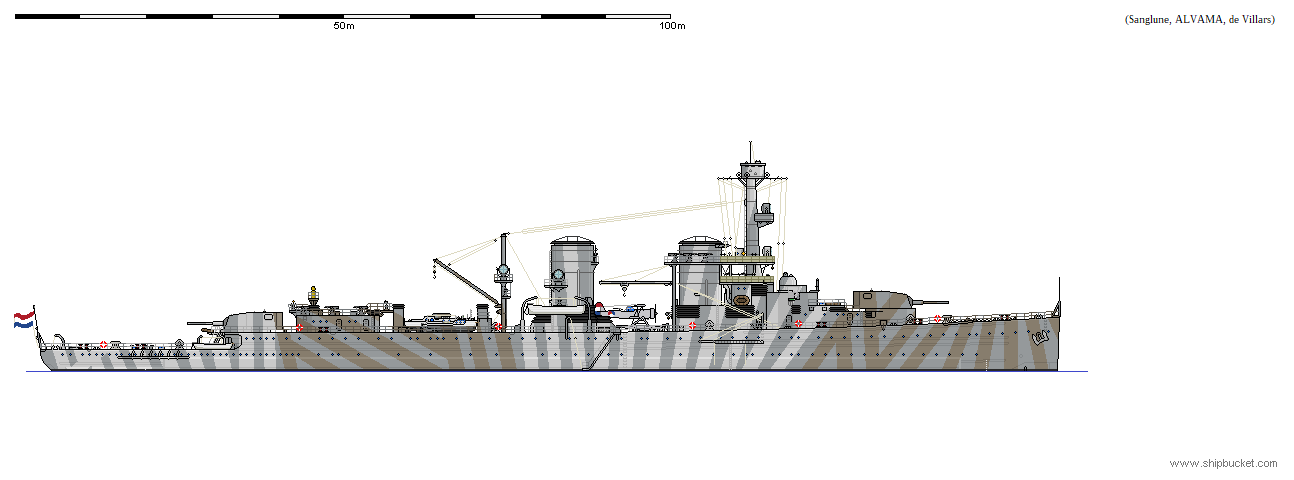W latach 30-tych w Holandii rozważano kilka projektów przebudowy krążowników lekkich typu Java. Wśród nich bodaj najciekawszy był pomysł niejakiego Hendrika-Alberta van Foreesta (1898-1971, dosłużył się stopnia wiceadmirała), postulujący przebudowę poprzez wymianę dotychczasowej artylerii na 6 dział kal. 180 mm w dwóch potrójnych wieżach (lekko podniesiona na dziobie i rufowa na wysokości uskoku kadłuba). Poza tym, okręt miał mieć tylko lekkie działka plot. i karabiny maszynowe. Bliższych szczegółów niestety brak, zwłaszcza odnośnie pochodzenia dział kal. 180 mm. Założyłem, że działa te to przeskalowany w górę projekt działa Boforsa kal. 150 mm o długości lufy 50 kalibrów, który był używany we flocie holenderskiej, w tym na krążownikach typu Java. Powstało w ten sposób działo kal. 180 mm, o długości L/50, strzelające pociskami o wadze 80,7 kg zapewne nie wolniej niż 4-5 razy na minutę
Lekkie działka plot to 40 mm pom-pomy w liczbie 12 szt., a ich uzupełnienie stanowią 4 km-y kal. 12,7 mm Browninga.
Inne zmiany w okręcie w stosunku do pierwotnego jego kształtu objęły zmianę masztu dziobowego na kolumnowy, likwidację masztu rufowego oraz zastąpienie go przez bom na śródokręciu, a także likwidację zabieranych min.
Java, dutch cruiser laid down 1916 (Engine 1921)
Displacement:
6 356 t light; 6 620 t standard; 7 050 t normal; 7 394 t full load
Dimensions: Length overall / water x beam x draught
509,50 ft / 502,59 ft x 52,49 ft x 18,01 ft (normal load)
155,30 m / 153,19 m x 16,00 m x 5,49 m
Armament:
6 - 7,09" / 180 mm guns (2x3 guns), 177,95lbs / 80,72kg shells, 1933 Model
Breech loading guns in turrets (on barbettes)
on centreline ends, evenly spread
12 - 1,57" / 40,0 mm guns in single mounts, 1,95lbs / 0,88kg shells, 1928 Model
Anti-aircraft guns in deck mounts
on side, all amidships, all raised mounts - superfiring
4 - 0,50" / 12,7 mm guns in single mounts, 0,06lbs / 0,03kg shells, 1919 Model
Machine guns in deck mounts
on side, all amidships, all raised mounts - superfiring
Weight of broadside 1 091 lbs / 495 kg
Shells per gun, main battery: 200
Armour:
- Belts: Width (max) Length (avg) Height (avg)
Main: 2,95" / 75 mm 398,69 ft / 121,52 m 12,96 ft / 3,95 m
Ends: 1,97" / 50 mm 49,28 ft / 15,02 m 4,99 ft / 1,52 m
54,63 ft / 16,65 m Unarmoured ends
Main Belt covers 122% of normal length
- Gun armour: Face (max) Other gunhouse (avg) Barbette/hoist (max)
Main: 5,91" / 150 mm 3,94" / 100 mm 5,91" / 150 mm
- Armour deck: 0,98" / 25 mm, Conning tower: 4,92" / 125 mm
Machinery:
Oil fired boilers, steam turbines,
Geared drive, 3 shafts, 56 937 shp / 42 475 Kw = 30,00 kts
Range 3 600nm at 15,00 kts
Bunker at max displacement = 773 tons
Complement:
384 - 500
Cost:
£1,001 million / $4,003 million
Distribution of weights at normal displacement:
Armament: 136 tons, 1,9%
Armour: 1 323 tons, 18,8%
- Belts: 637 tons, 9,0%
- Torpedo bulkhead: 0 tons, 0,0%
- Armament: 321 tons, 4,6%
- Armour Deck: 326 tons, 4,6%
- Conning Tower: 39 tons, 0,6%
Machinery: 1 961 tons, 27,8%
Hull, fittings & equipment: 2 887 tons, 40,9%
Fuel, ammunition & stores: 694 tons, 9,8%
Miscellaneous weights: 50 tons, 0,7%
Overall survivability and seakeeping ability:
Survivability (Non-critical penetrating hits needed to sink ship):
8 269 lbs / 3 751 Kg = 46,5 x 7,1 " / 180 mm shells or 1,2 torpedoes
Stability (Unstable if below 1.00): 1,15
Metacentric height 2,5 ft / 0,8 m
Roll period: 14,0 seconds
Steadiness - As gun platform (Average = 50 %): 59 %
- Recoil effect (Restricted arc if above 1.00): 0,47
Seaboat quality (Average = 1.00): 1,18
Hull form characteristics:
Hull has low quarterdeck
Block coefficient: 0,519
Length to Beam Ratio: 9,57 : 1
'Natural speed' for length: 22,42 kts
Power going to wave formation at top speed: 58 %
Trim (Max stability = 0, Max steadiness = 100): 50
Bow angle (Positive = bow angles forward): 2,00 degrees
Stern overhang: 5,97 ft / 1,82 m
Freeboard (% = measuring location as a percentage of overall length):
- Stem: 26,94 ft / 8,21 m
- Forecastle (14%): 23,43 ft / 7,14 m
- Mid (50%): 19,46 ft / 5,93 m
- Quarterdeck (20%): 10,96 ft / 3,34 m (19,46 ft / 5,93 m before break)
- Stern: 10,96 ft / 3,34 m
- Average freeboard: 19,27 ft / 5,87 m
Ship space, strength and comments:
Space - Hull below water (magazines/engines, low = better): 106,7%
- Above water (accommodation/working, high = better): 182,2%
Waterplane Area: 17 892 Square feet or 1 662 Square metres
Displacement factor (Displacement / loading): 110%
Structure weight / hull surface area: 95 lbs/sq ft or 462 Kg/sq metre
Hull strength (Relative):
- Cross-sectional: 0,94
- Longitudinal: 1,85
- Overall: 1,00
Hull space for machinery, storage, compartmentation is adequate
Room for accommodation and workspaces is excellent
2 seaplanes
Java (1921, rebuilt 1935)
Sumatra (1921, rebuilt 1935)





































